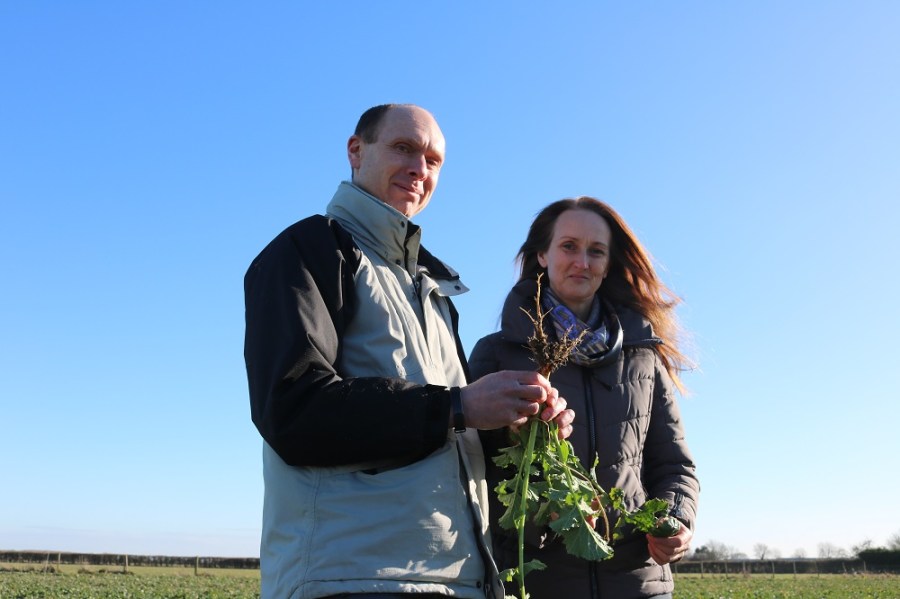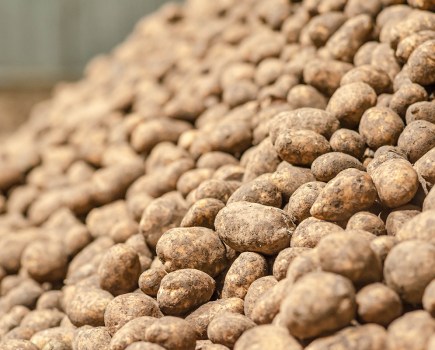Ongoing research into early spring management of oilseed rape is shedding light on how to unlock its potential. CPM summarises recent findings.
When light levels improve, these crops will really start to move.
By Tom Allen-Stevens
It’s hard to avoid oilseed envy when you wander into one of Russ McKenzie’s oilseed rape crops in early Feb. It’s not so much that there’s a lot of leaf area coming out of the winter on these heavy clays near the Northants/Cambs border. More that every plant has a robust vigour about it – like a coiled spring, just waiting for the warmer temperatures that will cause it to burst into growth.
The area marked out as BASF’s Real Results trial plots is where the differences are most distinct. Here, some of the practices to manipulate canopy size and growth are under close scrutiny, and BASF’s Clare Tucker pulls up the leaves on one plant to reveal the secret behind its vibrant potential.
“Just look at the root collar – you can see from the thickness of the stem here that there’s a good carbohydrate store. When light levels improve, these crops will really start to move,” she notes.
“But there are also crops across the UK that have suffered. It’s important to look at fields individually and decide for each what action to take this spring.”
There are three strands to consider, she says:
- Getting light into the lower canopy – this is achieved by reducing lodging and apical dominance (the relative contribution of the main raceme).
- Maintaining water uptake – the aim is to increase rooting at depth, while also preventing sclerotinia cankers, delaying verticillium. (Preventing phoma cankers is also important but this is an autumn/winter task.)
- Keeping leaves green – achieved through increasing the green leaf area duration and reducing levels of light leaf spot.
BASF funds an on-going programme of research on OSR, conducted by ADAS, that has refined understanding of how to manipulate the crop canopy to set it up for maximum potential.
The aim is optimum seed set, says ADAS head of crop physiology Dr Pete Berry. “There’s a good correlation between high-yielding years and sunny Aprils – that’s the period when seeds are set. But once you’ve built the seed numbers, you can’t just switch off – you have to keep the crop going.”
The aim is for a green area index (GAI) at flowering of around 3.5 – this benchmark has been well established through research. “We also now have plenty of data that shows the GAI threshold for PGRs containing metconazole is 0.8 – using Caryx (mepiquat chloride+ metconazole), for example, will help manage a canopy to maximise seed set, if the GAI reaches 0.8 before stem extension,” he notes.
Up to a GAI of 2.5, he recommends the BASF GAI smartphone app as the best way to get a reasonable assessment of crop cover. A new BASF-funded project is now underway, using data gathered by drones, satellite and aircraft that’s set to add a new dimension to how farmers can assess GAI.
Clare advises that crops with a GAI above 0.8 should be sprayed with Caryx any time between the start of stem extension (typically from mid-March onwards) to yellow bud. ADAS trials have shown the product has the effect of reducing lodging and increasing seeds/m², resulting in yield increases of up to 0.4t/ha.
“It contains enough triazole at the 1.4 l/ha rate to protect crops against light leaf spot attack. However, at the commonly used rate of 1.0l/ha, if the disease is active, tebuconazole at 0.5 l/ha should be added,” she notes.
Achieving an optimum sized canopy is by far the more effective way of maximising crop output stresses Pete. “I fully understand the pressure on growers to increase seed rates to combat pests, but the downside can be over-large canopies. Our trials have shown that increasing seed rates can lead to a reduction in yield, even in the absence of lodging, so it’s important to target these measures where the pest risk is high.”
Trials conducted by ADAS have shown the optimum seed rate is 25-40 plants/m². “If you establish lots of plants in the autumn, it’s unlikely you’ll achieve the full yield potential. However, there’s plenty you can do at the start of the spring to manipulate the canopy and bring about the best prospect for your crop.”
Counting the components of canopy care
A little bit of lodging can cause a lot of losses, according to BASF-funded research. What’s more, a better branch architecture of the crop above ground leads to better rooting down below.
Aerial surveys carried out in 2012 and 2014 sought to assess the extent of lodging in the UK crop. “There’s a lot more lodging than you’d think – it’s often hidden,” remarks Pete Berry. Of 3000ha surveyed, a staggering 31% was on the lean, he reveals.
“Taking those figures across the UK crop, that’s a loss of £45M if the crop is leaning at 45° at seed filling, while if it’s flat at flowering, growers would have lost £120M.”
Work carried out in 2013-15 has shown that each 5cm reduction in crop height results in a 10% reduction in lodging (e.g. reducing the area lodged from 30% to 20%). “That’s a very significant difference in lost crop, but you’d struggle to see the height difference.”
So trials carried out last year have looked at the effect of lodging in more detail. Trial plots were artificially lodged at three different angles (22.5°, 45° and flat – 90°) and at four different growth stages.
“We found that where the crop was laid flat, you lost not only around half the yield, but also 2-3% of the oil content. This was consistent for all growth stages, and that’s quite significant in terms of gross margin,” notes Pete.
But the most interesting results occurred where the crop was lightly leaned, he continues. “Where the crop lodges by just 20-25° what we found was that this leads to a yield loss of 20% and oil content reduction of at least 1% (see chart below).
Effect of lodging to 20-25° in OSR

Source: ADAS, 2017
“So any lodging is bad news for OSR – it reduces the crop’s ability to photosynthesise. What’s more, if it occurs late in the season, it has a disproportionately large effect on oil content.”
But holding back crop height through PGR use doesn’t just help with lodging – Pete reckons there are rooting benefits, too. “Caryx and Caramba have the effect on the plant of reducing gibberellic acid biosynthesis – the process through which cells in the stem extend. The crop is still producing assimilates, though, so it redirects them towards the root.”
And this can have a significant effect – other work carried out by ADAS has investigated root length density (RLD), with 1cm of root per cm3 of soil shown as the critical RLD for best uptake of available water and nutrients. An analysis of 40 crops from 2004-13 has revealed that the critical RLD tends to be inadequate below a depth of 40cm.
“We’ve found that spring applications of Caramba and Caryx increase RLD from 0.48 to 0.6 cm/cm3 at the 40-100cm depth. That leads to an estimated additional water uptake of 6-9mm and means a yield boost of 0.22-0.34t/ha in a dry year,” reports Pete.
So just how do PGR applications have such a profound effect? While it’s fairly difficult to assess rooting through the season, detailed measurements of crop architecture above ground have been taken. “We’ve spent a lot of time measuring branches and counting pods over several years, so we drilled down through the various field experiments to understand what Caryx does to a crop,” he continues.
“It not only holds back the main raceme, but encourages secondary branches. These contribute about 1-1.5t/ha of yield. Applications actually result in less pods produced by the terminal raceme, but more pods, more seeds/m² and a higher yield from the lower primary and secondary branches.
“Overall, the outcome for yield is positive,” concludes Pete.
Canopy control helps sclerotinia protection
A better canopy not only helps light get down to lower leaves, there’s a benefit for spray distribution later in the season, too.
BASF-funded work set out to establish this, explains ADAS plant pathologist Julie Smith. “We pegged water-sensitive paper onto leaves throughout the canopy of an OSR crop and applied a spray at mid flowering. Using image-analysis software, we measured the relative deposition.”
The work showed up “quite clear differences”, with more than double the deposition at every stage of the canopy resulting from an increase in water volume from 100 l/ha to 200 l/ha.
Coverage was also compared in crops that had been previously treated with Sunorg Pro (metconazole) or Tectura (boscalid+ metconazole) at the yellow bud stage (see chart below).
“The significant finding was that there was an increase in deposition in the bottom two thirds of the canopy where crops had been held back,” notes Julie.
“We know that the most damaging sclerotinia lesions come from the bottom to mid third of the canopy but this is a difficult area to target with mid-flowering fungicides due to poor spray penetration, and this work confirmed that, with the smallest stem lesions occurring where Tectura had been applied.”

Product plan for canopy care
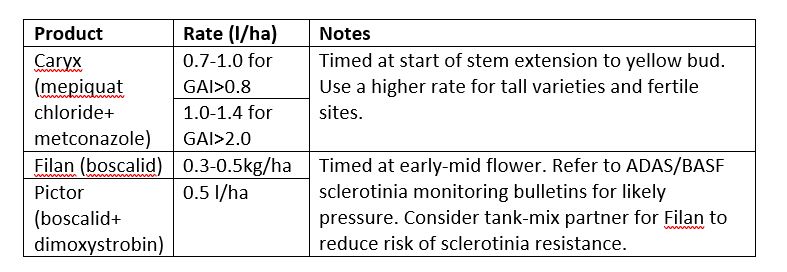
Aren’t you GLAD you kept the leaves green?
It can be difficult to assess whether you’re actually getting value out of your sclerotinia spray, as far as its fungal control is concerned. But ongoing work by ADAS on green leaf area and duration (GLAD), funded by BASF, is refining understanding of the contribution to yield you can have simply by maintaining green leaf area.
The project has run since 2014 over a total of nine site seasons, explains Julie Smith. “Leaves are the most photosynthetically active organ of an OSR plant but there’s a rapid decline in green leaf area from mid-flowering onwards in an ordinary, healthy crop. Maximising yield means achieving the optimum canopy size then maintaining this green leaf fraction of the crop through the critical yield forming period. Our research shows that extending it by a relatively small amount can lead to yield increases of up to 0.5 t/ha.”
Measuring green leaf area index at mid flower gives you a snapshot of canopy size but doesn’t give you any information about canopy duration, she continues. “We’ve incorporated both into our research and have been measuring the decline of green leaf area through time, from mid-flowering to green/brown seed, and relating the accumulated leaf area and corresponding accumulated absorbed light to actual yield.”
This has the effect of making the relationship quite robust, she adds, because taking accumulated data removes extraneous variation and allows you to compare between sites and seasons.
Untreated crops have been compared with those where Pictor (boscalid+ dimoxystrobin) has been applied at mid flowering (see chart below). “The 2014 trials showed a linear relationship whereby the untreated crops had a relatively low GLAD and yield, but both increased where Pictor was applied. There was no sclerotinia or canker and very low levels (<1%) of light leaf spot in the trials, so the increases were not due to disease control,” she notes.
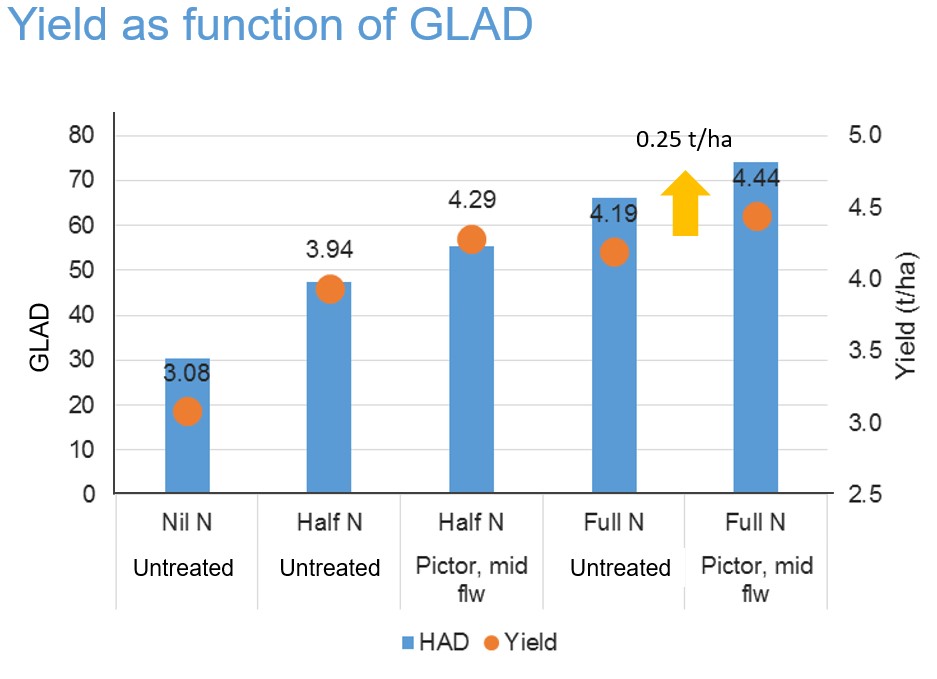
Source: ADAS, five site seasons, 2014-16
In 2015, the trial was repeated, but the yield plateaued despite boscalid increasing GLAD. “This was something of a light-bulb moment for me,” says Julie.
“It shows that the fungicide still performed and increased GLAD as expected but the crop reached a point beyond which it couldn’t produce any more yield regardless of how well healthy leaves were maintained. Other factors such as lack of sunshine, water availability or sink capacity could have limited yield in these crops.”
On average boscalid brings about a 0.25t/ha yield advantage in the absence of disease. “But it’s not just about ensuring the right canopy and increasing GLAD. It also comes down to how much sunshine is available, and that’s something you can’t influence.”
Comparing yield data from the project against meteorological data on accumulated light levels reveals a very close relationship – a curve that plateaus (see chart below). “In a year with a lot of sunshine, you’d see the results spread out along the curve. But where levels of sunshine are low, such as in 2012, that would pull back the high-yielding points and this is where the benefit of increasing GLAD is maximised,” Julie surmises.
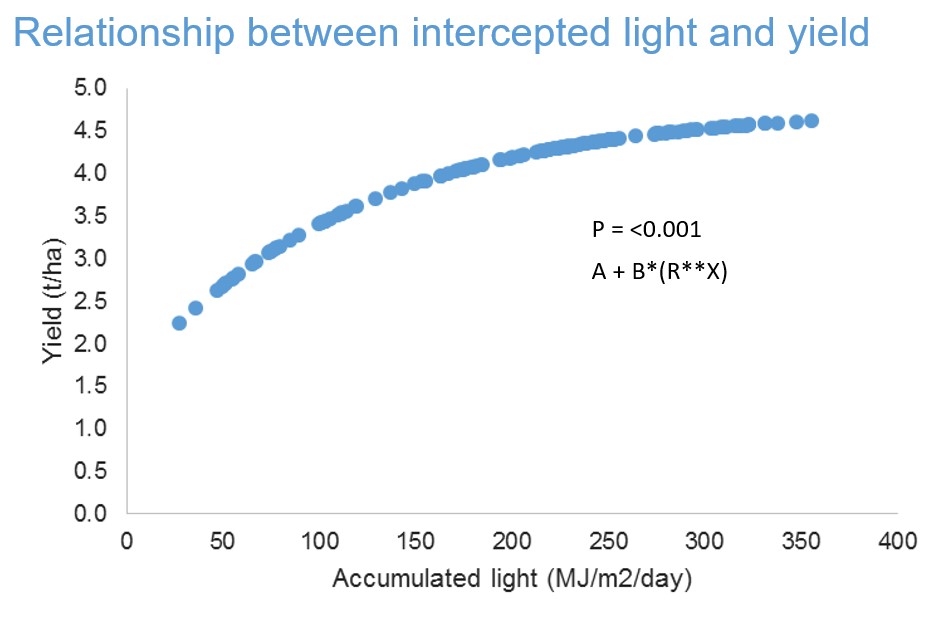
Source: ADAS, five site seasons, 2014-16
Research Briefing
To help growers get the best out of technology used in the field, manufacturers continue to invest in R&D at every level, from the lab to extensive field trials. CPM Research Briefings provide not only the findings of recent research, but also an insight into the technology, to ensure a full understanding of how to optimise its use.
CPM would like to thank BASF for sponsoring this Research Briefing and for providing privileged access to staff and material used to help bring it together.
Based on a decade of R&D, in partnership with ADAS, BASF has identified three simple rules for spring management, for oilseed rape to yield profitably. The first is to get the light into the canopy – by reducing lodging and creating an open canopy –the PGR, Caryx, can be useful for this. The second is to maintain water uptake – by increasing rooting at depth and preventing sclerotinia – Caryx, Filan and Pictor can help achieve these aims. The third is to keep the leaves green – by reducing light leaf spot and maximising Green Leaf Area Duration (GLAD) – Filan and Pictor have been proven to extend GLAD. For more details go to www.basfrealresults.co.uk/OSR

